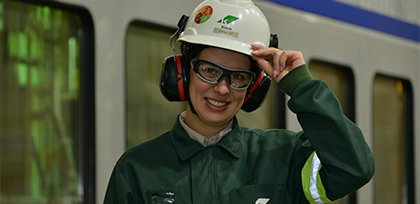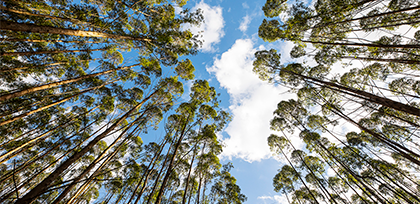Multiple uses of wood
Ingredients for sustainable applications
Through Research, Development, and Innovation, it is possible to draw components from forests for a variety of applications. Klabin has made strides in developing more sustainable applications for its products, seeking out renewable and biodegradable barriers (such as oxygen, water vapor, and fat) to meet the needs of conscious consumers. The Company's R&D+I work in this area is increasingly directed towards these applications. One example of the area's vitality and the increased demand is that, in 2022, Klabin's laboratories and Technology Center began operating in shifts.
Solution in corrugated cardboard packaging for frozen foods.
From development to application
The Research & Development team, which started with four people, currently has 66 professionals who work in two shifts, a differentiated structure for an R&D team around the world. The Pilot Plant Park, which began operations in 2019, is responsible for delivering a variety of MFC products to the market.
Ingredients developed |
Application |
|---|---|
Microfibrillated cellulose (MFC) is a microparticle of cellulose that provides properties such as increased mechanical strength of paper due to the ease of intertwining of microscopic-sized fibers, as well as other properties. |
Beverage packaging, cosmetic products, water-based paints, hand sanitizer, cleaning products. |
Lignin: a natural polymer and component of wood used in pulp manufacturing, separated after the cooking process, being a renewable alternative to petroleum-based products. |
Resins and plastics, facilitating the biodegradation process. |
Turpentine: a chemical extracted from pine, either in the cooking of wood in the production of paper or directly from it. |
Pharmaceutical industry, food industry, cosmetic products. |
Crude tall oil – unrefined – produced after acidulation of black liquor soap (extracted from pine) present in the chemical recovery process of pulp production. |
Resins, cosmetics, fuels and hot glue. |
Partners in Brazil and abroad
Investing in R&D+I for the development of new products and partnerships with other organizations is a target that is included in the Klabin 2030 Agenda. In 2022, BRL 43.6 million was invested in research, development, and industrial innovation, and BRL 20.2 million in the forestry R&D+I sector, representing increases of 70% and 29%, respectively, compared to the amounts invested in 2021. The organizations Klabin partnered with in 2023 are listed below.
-
Associação Brasileira Técnica de Celulose e Papel (ABTCP) [Brazilian Pulp and Paper Technical Association]
-
Comitê de Produtores – Tappi Nano [Producers Committee – Tappi Nano]
-
Embrapa Florestas
-
Escola Superior de Agricultura Luiz de Queiroz (Esalq)
-
Melodea
-
Pine Chemicals Association International
-
Research Institutes of Sweden (RISE)
-
National Industrial Training Service (Senai)
-
Unicamp
-
University of Karlstad (Sweden)
-
University of Leuven (Belgium)
-
University of Toronto
-
North Carolina State University (NCSU)
-
Universidade do Estado de Santa Catarina
-
Universidade Estadual de Ponta Grossa
-
Universidade Federal de Lavras
-
Universidade Federal de Uberlândia
-
Universidade Federal de Viçosa
-
Universidade Federal do Espírito Santo
-
Universidade Federal do Paraná
-
Universidade Federal do Rio de Janeiro
-
VTT Technical Research Centre of Finland











